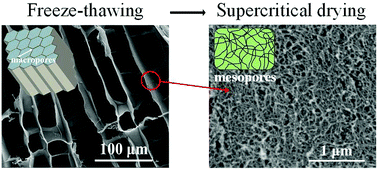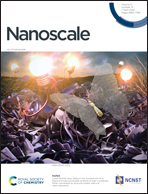Dual-porous cellulose nanofibril aerogels via modular drying and cross-linking†
Abstract
Nanofibrillar foams and aerogels are traditionally either macroporous with low surface area and high mechanical strength, or mesoporous with high surface area and low mechanical strength. In this work, an anionic cellulose nanofibril (CNF)-based dual-porous aerogel with BET specific surface area up to 430 m2 g−1 was prepared via a modular process combining directional freeze-thawing (creating macro-pores, ca. 50–200 μm) and supercritical drying (creating meso-pores, ca. 2–50 nm). Furthermore, by optionally utilizing both physical and chemical cross-linking strategies, aerogels with a Young's modulus of up to 711 kPa and good stability in aqueous conditions were demonstrated. By altering cross-linking strategies, the properties of resulting aerogels, such as hydrophilicity, mechanical strength and stability in water, can be precisely controlled for different applications. As a result, cationic methylene blue (MB) and metal ions (Ag+) were chosen as model species to investigate the absorption properties of the physically cross-linked aerogels in water. The aerogels showed a maximum adsorption of MB up to 234 mg g−1 and of Ag+ up to 116 mg g−1 as a result of the high specific surface area of the aerogels and their strong electrostatic interaction with the model species. Importantly, the hierarchical dual porosity of the aerogels enabled fast adsorption kinetics combined with a considerable adsorption capacity overall. Finally, it was shown that the adsorbed Ag+ could be converted to metallic Ag, demonstrating the additional functionality of these dual porous hybrid aerogels for antibacterial or catalytic applications.



 Please wait while we load your content...
Please wait while we load your content...